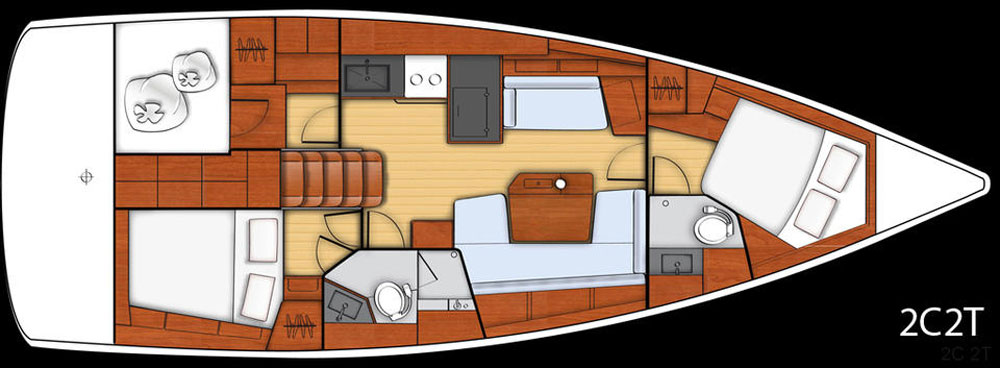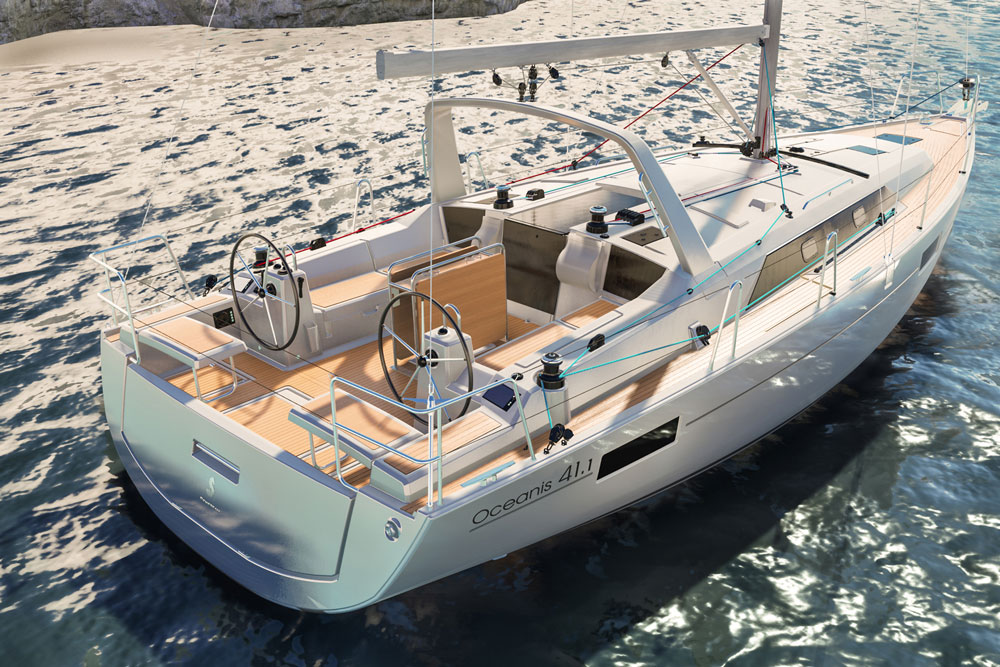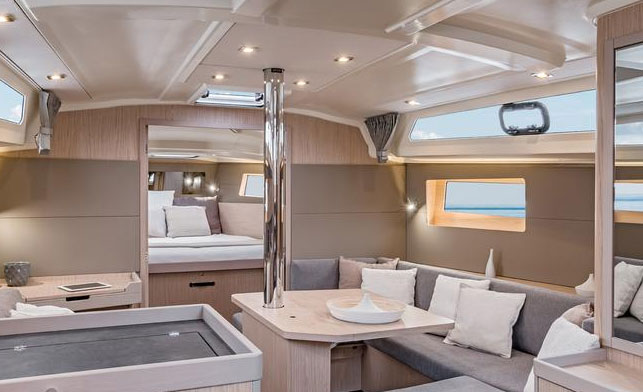Beneteau Oceanis 41.1: Sailing Towards Perfection
A popular Beneteau Oceanis model gains real improvements, based on owner feedback.
The Beneteau Oceanis model line is huge, ranging from the smallest 31 and the Oceanis 35 all the way up to the flagship Oceanis 60. The newest model in the fleet? The popular Benetau Oceanis 41 gained a decimal point in 2016, when it became the 41.1. Although basically the same boat, the new model made some real improvements saving over 1200 pounds, which results in slightly better performance. Also, moving the rig aft brought significantly enhanced livability below.
The cabin house on the new 41.1 is low with elongated fixed ports and flush hatches. Overall, she remains an attractive design and nothing in the re-imagination took away from her sleek lines, initially drawn by Finot-Conq. The blunt bow, 13’ 9” beam and the signature Beneteau hard chine are all still visible as before.
However, the Zspar mast was moved aft, which improved the flow of the interior below and opened up the fore triangle for better sail options. The 41.1 now has a standard 95% self-tacking jib on a recessed track just ahead of the mast. Upwind and in boisterous conditions, this will be the go-to sail. For downwind work, a Code 0 will make all the difference.
The total weight savings came from reducing the amount of interior wood trim and from modifying the transom, which still drops down to form a swim platform but no longer has a continuous integrated seat. Lightweight seats were added at the twin wheels. They stow by hinging up and out of the way, which opens up the transom for easy boarding from a dinghy or dock.
Like all Beneteau cockpits, this one is large and functional. Twin helms with optional carbon wheels offer clear sightlines forward. Engine controls are on the port side only, while B&G multifunction displays are at both helms. Just ahead, two bench seats are separated by a massive drop-leaf table, able to seat six for dinner. An optional refrigerator can be built in so cool drinks are close at hand. If the two-cabin layout is chosen below, an enormous stowage locker is under the portside cockpit seat. It’s garage-like stowage at its finest, with room for everything needed for cruising as well as optional equipment installation. You can take a peek at the cockpit in a First Look Video of the 41.1, which reviewer Dieter Loibner shot at the Dusseldorf International Boat Show.
On-deck options include in-mast furling for the mainsail, a double bow roller, a sprit that provides an attach point for a gennaker, an adjustable backstay, laminated sails, electric winches, and teak slatting on the cockpit seats and sole.
Personalization is still the focus of the Oceanis line and there are four possible layouts for the 41.1. Both ends of the boat may be modified while the middle saloon, galley, and head stay the same. Aft, there is a choice of a two guest cabins or one cabin and that fantastic stowage to port, accessible via the cockpit as mentioned above, or via an interior door below. Forward, the master stateroom underwent the greatest change and is available in two orientations: either with a centerline berth, three overhead hatches and lots of stowage, or with a berth angled to starboard and an added head that eats up one of the hatches. I personally don’t like to shoehorn a head/shower combination into the master suite but for chartering or large families, this is a viable option.

Shown here with the two stateroom/two head layout, the Oceanis 41.1 can also be arranged with three staterooms.
Either way, this cabin gained lots of space as the deck-stepped mast moved aft. The compression post is now behind the double doors in the saloon. With these doors open the boat feels longer and more spacious, while with them closed, two or three couples can enjoy privacy aboard.
A small forward-facing desk is to port in the saloon. It’s a nav desk of sorts that will most likely be used for stowage of various navigation and communication items, since chart work today happens mostly on chartplotters. An option I wish Beneteau would explore is to offer a straight settee on the port side with a drop-down middle cocktail table that would allow the bench to be used as a sea berth.
The dinette is U-shaped and wraps around a large drop-leaf table that connects the two sides of the boat for dining. Two sets of bottle stowage are within so there’s no shortage of places to stow wine for the weekend. The main head with a separate shower stall follows to starboard. Just across to port, the galley is L-shaped with a two-burner stove, top and side-loading refrigeration, and a single sink. Stowage is adequate with a column of soft-close drawers and outboard lockers.
The fixed hull and deck ports were made larger in the revamp. Not only does this bring in more light, it cuts down on the use of weighty wood. Our test boat had dark grey fabric trim panels that ran the perimeter of the saloon. It’s a nice way to break up the wood finish, but white panels that match the headliner would make the boat seem brighter and bigger, and are an option.
Everyone always wants to know how a boat will handle in 30 knots and rough seas. Truth be told, those conditions are rare, rarer still on a test sail. Instead, we got to check out the performance at the opposite extreme. The day produced a breeze of only six to eight knots and we had an easy day on the flat water of Biscayne Bay. Age-old wisdom says that light winds separate the good sailors from the bad, but it also differentiates between a boat that will sail home from one that has to turn on the iron genoa.
With the upgraded Elvstrom laminate sails, we managed to sail 6.9 knots in 8.0 knots of true wind at 75 degrees. We all took note when the boat accelerated to 7.5 knots in a 10-knot puff, on a beam reach, as we glided smoothly over the small ripples. Not that we needed the optional electric winches, they did make our afternoon that much easier. And although we had a crew of five aboard, with the simplicity of the self-tacking jib, this proved to be a perfect boat for two—or even one, for that matter.
The 45 HP Yanmar diesel with saildrive pushes the boat on flat water at 8.5 knots at 3000 rpm, which is wide-open-throttle. A fast cruise would be more like 7.4 knots at 2200 rpm. While 53 gallons of fuel is not a lot, it’s plenty for a 20,000-pound vessel with an engine that only burns a half a gallon per hour.
With the old 41 model, couples had to either live with a suboptimal master stateroom or step up in length. For some, that was too much of a leap in the pocketbook and in slip length. Beneteau has solved that with the 41.1. Also, with the addition of the self-tacking jib, the new model became easier to manage, even singlehanded. Two great improvements and a slimming down in overall weight to boot–that’s the power of listening to the customer.
As to the new name? It’s kind of like a revision in software. Besides, it was the easiest thing they could come up with in the bar–true story.
Other Choices: Some other sailboats of interest in this size range include the Hanse 415, the Marlow-Hunter 40, and the Blue Jacket 40.
See Beneteau Oceanis 41.1 listings.
For more information, visit Beneteau.
| Specifications | |
|---|---|
| Length | 40'9" |
| Beam | 13'9" |
| Draft (shoal/deep) | 5'7"/7'2" |
| Displacement | 19,350 lbs |
| Fuel capacity | 53 gal. |
| Water capacity | 63 gal. |



















